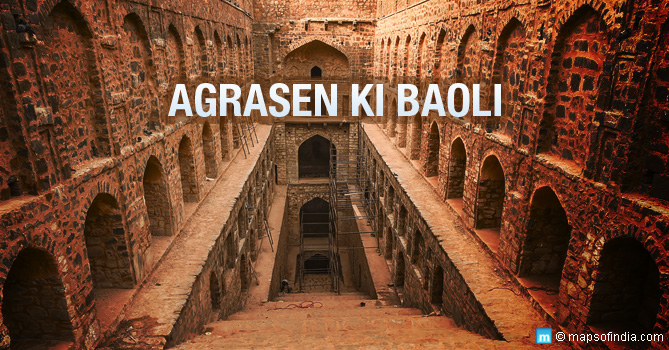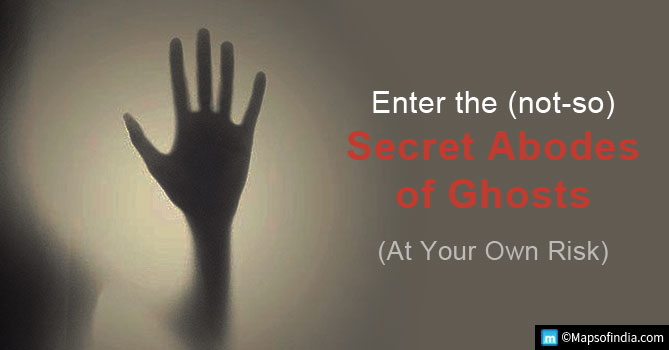 Agrasen Ki Baoli came to national attention with PK, the Bollywood film featuring Aamir Khan, Anushka Sharma and Sushant Singh Rajput. It has been staying hidden among the multi-storey buildings of Connaught Place for several decades now. When one looks at the photos of the baoli from the 1920s, one can see acres of open space surrounding it. The grand structure has been a silent testimony to the city’s history and a keeper of its many secrets. This elaborate structure has 108 steps leading to what used to be the well. It is mostly frequented by college students in Delhi as well as locals during summers because of the comfort it provides from the searing heat in the city.
Agrasen Ki Baoli came to national attention with PK, the Bollywood film featuring Aamir Khan, Anushka Sharma and Sushant Singh Rajput. It has been staying hidden among the multi-storey buildings of Connaught Place for several decades now. When one looks at the photos of the baoli from the 1920s, one can see acres of open space surrounding it. The grand structure has been a silent testimony to the city’s history and a keeper of its many secrets. This elaborate structure has 108 steps leading to what used to be the well. It is mostly frequented by college students in Delhi as well as locals during summers because of the comfort it provides from the searing heat in the city.
How did a Bollywood flick become a boon for Delhi’s architectural treasures?
PK has indeed aroused interest for this centuries-old structure among Indian – as well as – international tourists. The publicity generated by the film has proven to be beneficial not only for Agrasen but also for other baolis in Delhi. Some of these structures have been disappearing rather quickly over the years while others are in a poor shape and in dire need of some attention. Agrasen, which is the oldest monument in central Delhi, remains one of the best preserved specimens of its species. Archaeological Survey of India (ASI) has preserved it – one look at an old photograph by Raghu Rai will show the extent of the commendable repair work put in by the said body. The same photograph taken in the 1970s shows that the well was full of water till then.
Where is it located?
Agrasen Ki Baoli is located at Harrow Lane, a narrow space, in the vicinity of Hailey Road in Connaught Place. India Gate is located at a distance of two km from here and Jantar Mantar is within a distance of 1.5 km. Thus, among all the baolis of Delhi, this one is the most easily-accessible one. The monument stays open from 7 am to 6 pm everyday and no entry fee is required.
Is it difficult to find the baoli?
Thanks to the crowd of high rises surrounding the age-old structure one needs to be rather inquisitive about the baoli in order to find it out. This is why if you try and find it out for the first time you will be surprised to see that not many people know where exactly it is located. However, these very people may have been working pretty close to it for many years. The baoli is said to be the easiest to get to from the metro stations at Barakhamba Road and Janpath. It is also at walking distance from every major hotel in central Delhi.
Is it Ugrasen Ki Baoli or Agrasen Ki Baoli?
Officially this structure is known as Ugrasen Ki Baoli, as the plaque – made from red sandstone – outside will inform any visitor. However, it has had other names over the years as well. According to a National Archives of India map – made in 1868 by the British – this monument is listed as Oojer Sain’s Bowlee. The map also shows another similar structure towards the northwestern direction of this structure. It may have gone missing ever since urban expansion started in Delhi in 1911. This was also the time when the capital of British India was shifted from Calcutta to Delhi.
Origins and history
From the design of Agrasen Ki Baoli it seems to have been built during either Lodi era or the later part of the Tughlaq dynasty. Legend, however, says that it was built by Maharaja Agrasen (Emperor according to some). It is said that he lived in Agroha, an ancient town in modern-day Haryana, during the Mahabharata era. He was born presumably in 3124 BCE and may have been Lord Krishna’s contemporary. There is also a small mosque in the western corner of the baoli. The mosque’s roof is not there – in fact, in old photos and records too, the structure is shown the same way. The columns of the mosque are full of motifs that resemble ones used in Buddhist structures like chaityas – something rather unusual.
Is it haunted?
There are several stories about how the baoli is haunted and it is said that the supposedly-black water over here entices people to commit suicide. However, it is difficult to ascertain the truth of such sayings. In reality the baoli does not have sufficient water and the little water it has is not black at all. However, the lowest part – which was once the well – houses hundreds, if not thousands, of bats. If you walk down the steps that lead to the pit, you will hear the commotion created by them. However, there has been one incident of suicide over here in 2007 which was reported in media. The water at that time was supposed to be 4-5 feet in depth. All these stories however have made the baoli popular and fetched it plenty of attention from the local people.
Read More:
Places to Visit in Delhi
Most Haunted Places of Delhi
Famous Temples in Delhi
Swaminarayan Akshardham Temple in Delhi
Jhandewalan Mandir in Delhi
Metro Walk in New Delhi : Entry Fee, Timing, Address, Rides
Chidiya Ghar – National Zoological Park in Delhi
Dilli ka Lal Qila
India Gate History
Pratapgarh Farms – A Weekend Getaway from Delhi
Nizamuddin Dargah in Delhi
Fun n Food Village in Delhi
Worlds of Wonder
Splash – The Water Par in Delhik
Just Chill Water Park
Kalindi Kunj Water Park
The Garden of Five Senses, New Delhi
The Iconic Dolls Museum in Delhi
ISKCON Temple in Delhi
National Science Centre, New Delhi
The Mystical Tomb of Ghiyasuddin Tughlaq in Delhi
Five Most Amazing Gardens of Delhi
Lal Kot: The ‘Real’ Red Fort Of Delhi
A Pottery Village in Delhi
Dilli Haat or shall we call it ‘Mini India’?
The National Rail Museum in the Heart of the Capital City




